True question link:
Completion
Question A: doorplate making (5 points)
Problem Description:
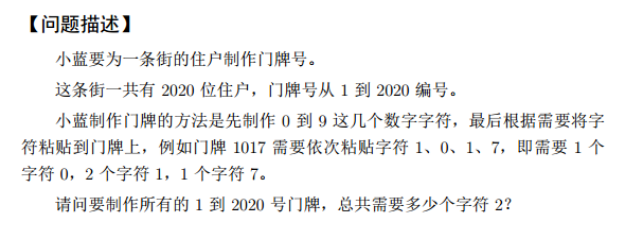
Brief description of ideas:
Solution 1:
The while loop decomposes the number on each bit
code:
public static void main(String[] args) {
int ans=0;
for(int i=1;i<=2020;++i){
int a=i;
while(a!=0){
if(a%10==2)ans++;
a/=10;
}
}
System.out.println(ans);
}
Solution 2:
String traversal
code:
public static void main(String[] args) {
int ans=0;
for(int i=1;i<=2020;++i){
String s=String.valueOf(i);
if(s.contains("2")){
for(char c:s.toCharArray()){
if(c=='2')ans++;
}
}
}
System.out.println(ans);
}
Reference results:
624
Question B: looking for 2020 (5 points)
Problem Description:
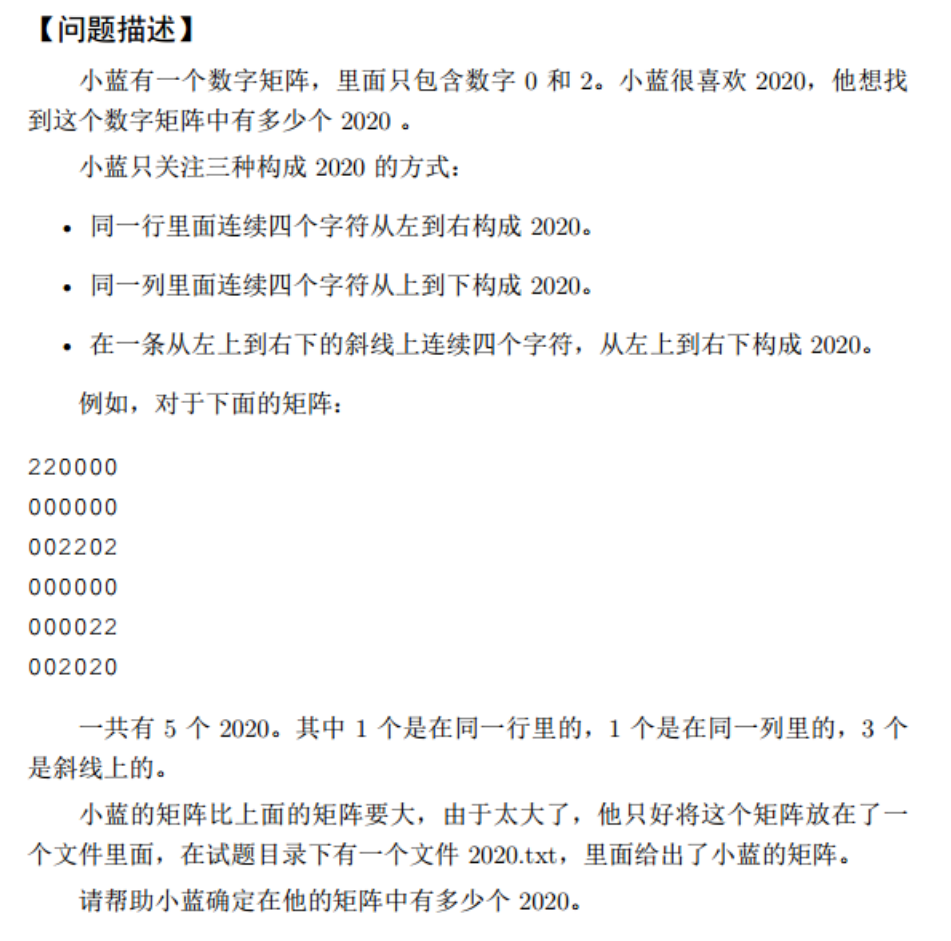
**2020.txt file Click here **
Brief description of ideas:
Document 2020 Txt has 300 rows and 300 columns
Traverse each point to find the number of current points combined with right 3, lower 3 and oblique lower 3 to 2020
code:
public static void main(String[] args) throws IOException {
BufferedReader in=new BufferedReader(new FileReader("2020.txt"));
String s;
int n=300,k=0;
int [][]a=new int[n][n];
while((s=in.readLine())!=null){
for(int i=0;i<n;++i)
a[k][i]=s.charAt(i)-'0';
++k;
}
// For (int i = 0; I < n; + + I) {/ / directly enter 2020.txt on the console
// String s=scanner.next();
// for(int j=0;j<n;++j){
// a[i][j]=s.charAt(j)-'0';
// }
// }
int ans=0;
for(int i=0;i<n;++i){
for(int j=0;j<n;++j){
if(j<n-3){
if(a[i][j]==2&&a[i][j+1]==0&&a[i][j+2]==2&&a[i][j+3]==0)ans++;
}
if(i<n-3){
if(a[i][j]==2&&a[i+1][j]==0&&a[i+2][j]==2&&a[i+3][j]==0)ans++;
}
if(i<n-3&&j<n-3){
if(a[i][j]==2&&a[i+1][j+1]==0&&a[i+2][j+2]==2&&a[i+3][j+3]==0)ans++;
}
}
}
System.out.println(ans);
}
Reference results:
16520
Question C: snake number (10 points)
Problem Description:
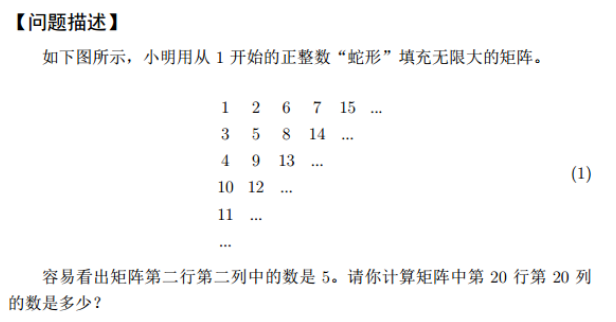
Brief description of ideas:
Solution 1:
Row 20 and column 20 are located in the oblique number row 20 * 2-1 = 39. Find the first and last numbers of row 39 and calculate 742 + (780-742) / 2 = 761.
code:
public static void main(String[] args) {
int n=39,a=0,sum=0;
for(int i=1;i<=n;++i){
a++;sum+=a;
System.out.println(sum);
}
System.out.println("\n"+((sum-a+1)+a/2));
}
Solution 2:
Simple simulation. Use the two-dimensional array a to store the oblique number of 39 lines.
code:
public static void main(String[] args) {
int n=20*2-1;
int [][]a=new int[n][n];
int i=0,j=0,cnt=1;
for(int k=0;k<n;++k){
if(k%2==0){
while(j<k){
a[i][j]=cnt++;++j;--i;
}
if(j==k){
a[i][j]=cnt++;++j;
}
}
else{
while(i<k){
a[i][j]=cnt++;++i;--j;
}
if(i==k){
a[i][j]=cnt++;++i;
}
}
}
for(int k=0;k<n;++k){
for(int l=0;l<n-k;++l){
System.out.print(a[k][l]+" ");
}
System.out.println();
}
System.out.println("\n"+a[19][19]);
}
Reference results:
761
Question D: seven segment code (10 points)
Problem Description:
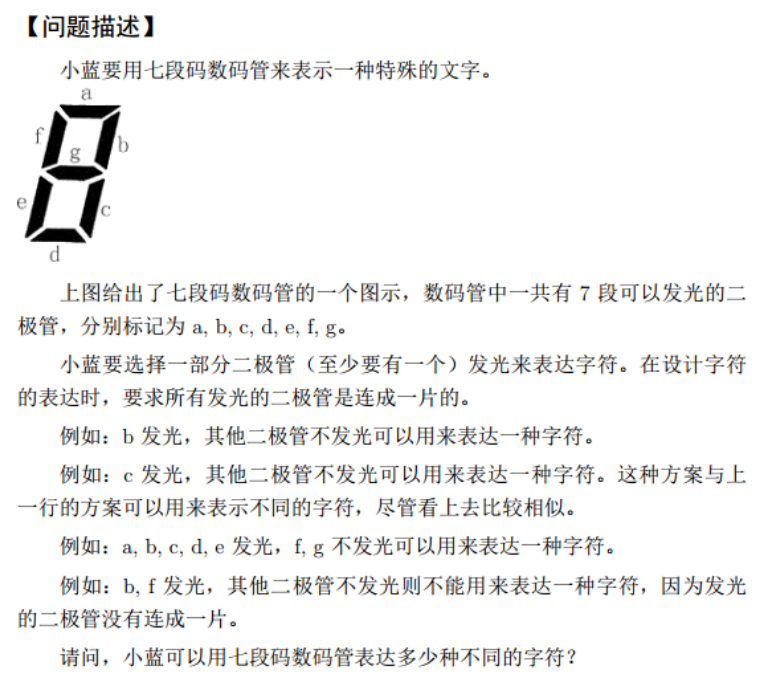
Brief description of ideas:
Solution 1:
Enumerate 2n cases.
- Only one tube of light meets the conditions
- If the x light is on and other tubes connected to x are not on, the conditions are not met
- Finally, deduct the disqualification (abde,facd,bcef) when 4 tube lamps are on and 2 tube lamps are connected together
code:
public static void main(String[] args) {
int ans=0;
for(int a=0;a<2;++a){
for(int b=0;b<2;++b){
for(int c=0;c<2;++c){
for(int d=0;d<2;++d){
for(int e=0;e<2;++e){
for(int f=0;f<2;++f){
for(int g=0;g<2;++g){
int sum=a+b+c+d+e+f+g;
if(sum==0)continue;
else if(sum==1){
ans++;
}
else{
int flag=0;
if(a==1&&b==0&&f==0)flag=1;
if(b==1&&a==0&&g==0&&c==0)flag=1;
if(c==1&&b==0&&g==0&&d==0)flag=1;
if(d==1&&c==0&&e==0)flag=1;
if(e==1&&d==0&&f==0&&g==0)flag=1;
if(f==1&&a==0&&e==0&&g==0)flag=1;
if(g==1&&f==0&&e==0&&b==0&&c==0)flag=1;
if(flag==0)ans++;
}
}
}
}
}
}
}
}
System.out.println(ans-3); //Subtract ABDE, facd and BCEF
}
Solution 2:
dfs + joint search set
code:
private static int n=7;
private static int ans=0;
private static int[][]mp=new int[n][n];
private static int[]v=new int [n];
private static int[]f=new int [n];
private static void un(int a,int b) {
mp[a][b]=1;mp[b][a]=1;
}
private static int find(int a) {
if(a!=f[a])f[a]=find(f[a]);
return f[a];
}
private static void dfs(int c) {
if(c==7){
for(int i=0;i<n;++i)f[i]=i; // initialization
for(int i=0;i<n;++i){ // Traverse all possible nixie tubes with lights on
for(int j=i+1;j<n;++j){
if(mp[i][j]==1&&v[i]==1&&v[j]==1){
// i. J is on the right and I and j are on
int a=find(i),b=find(j);
if(a!=b)f[b]=a; // Merge two sets
}
}
}
int cnt=0;
for(int i=0;i<n;++i)
if(v[i]==1&&f[i]==i)cnt++;
if(cnt==1)ans++; // All lights belong to the same set
return;
}
v[c]=1; // Light up
dfs(c+1);
v[c]=0; // Lights out
dfs(c+1);
}
public static void main(String[] args) {
// 0~6 --> a~g
// Connecting accessible edges
un(0,1);un(0,5);
un(1,2);un(1,6);
un(2,6);un(2,3);
un(3,4);
un(4,5);un(4,6);
un(5,6);
dfs(0);
System.out.println(ans);
}
Illustration:

Reference results:
80
Test question E: ranking (15 points)
Problem Description:
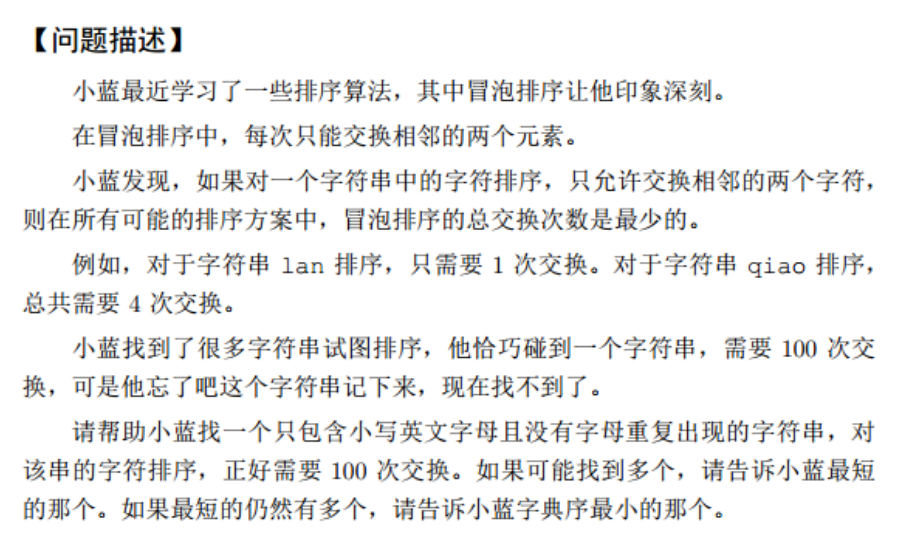
Brief description of ideas:
14 nmlkjihgfedcba 91
15 onmlkjihgfedcba 105
The answer should be a string of length 15
Move onmlkjihgfedcba the 6th character to the first position
Get jonmlkihgfedcba and verify it
code:
public static void main(String[] args) {
String s="";
for(int i=0;i<20;++i){ // Look at the watch first
s=(char)(i+'a')+s;
int cnt=count(s);
System.out.println((i+1)+" "+s+" "+cnt);
}
s="jonmlkihgfedcba";
int cnt=count(s); // verification
System.out.println(s+" "+cnt);
}
private static int count(String s) {
char []c=s.toCharArray();
int n=c.length,cnt=0;
for(int i=0;i<n-1;++i){ // Bubble sorting
for(int j=0;j<n-i-1;++j){
if(c[j]>c[j+1]){
char t=c[j];
c[j]=c[j+1];
c[j+1]=t;
cnt++;
}
}
}
return cnt;
}
Reference results:
jonmlkihgfedcba
Program questions
Test question F: score analysis (15 points)
Answer link:
Problem Description:
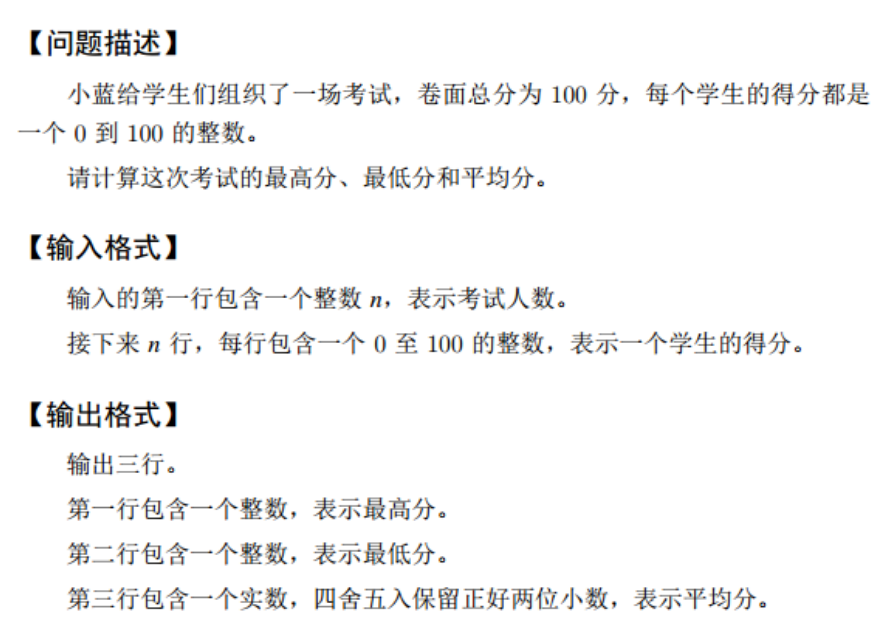

-
sample input
7 80 92 56 74 88 99 10
-
sample output
99 10 71.29
Brief description of ideas:
Simple simulation
code:
public static void main(String[] args) {
Scanner scanner=new Scanner(System.in);
int n=scanner.nextInt();
double sum=0;
int ma=0,mi=100;
for(int i=0;i<n;++i){
int a=scanner.nextInt();
ma=Math.max(ma, a);
mi=Math.min(mi, a);
sum+=a;
}
System.out.println(ma);
System.out.println(mi);
System.out.printf("%.2f\n", sum/n);
}#include<iostream>
using namespace std;
int main(){
int n,score,pass=0,excellent=0;cin>>n;
for(int i=0;i<n;++i){
cin>>score;
if(score>=60)pass++;
if(score>=85)excellent++;
}
cout<<(int)(pass*100.0/n+0.5)<<"%"<<endl;
cout<<(int)(excellent*100.0/n+0.5)<<"%"<<endl;
return 0;
}
Question G: word analysis (20 points)
Answer link:
Problem Description:
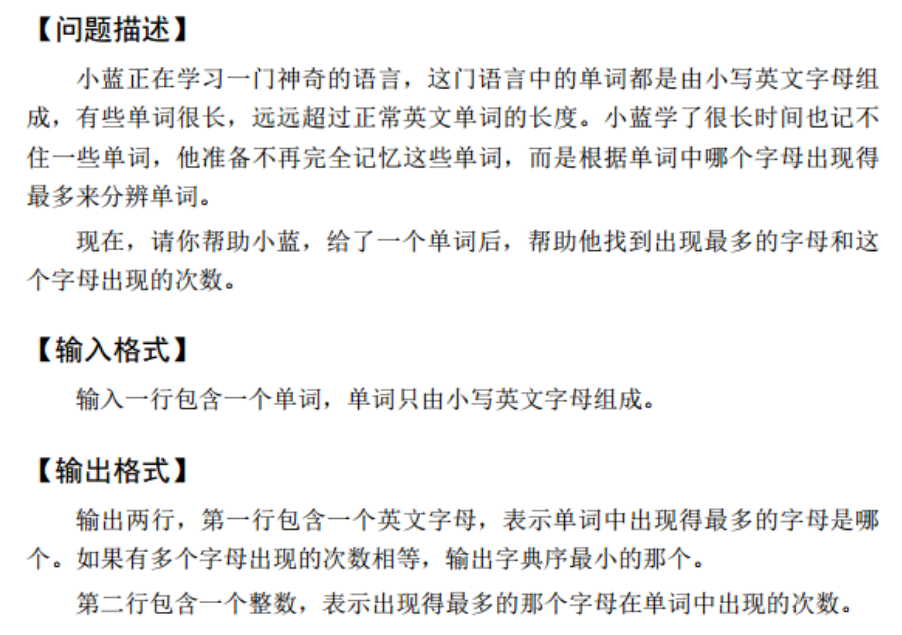

-
Sample input 1
lanqiao
-
Sample output 1
a 2
- Sample input 2
longlonglongistoolong
-
Sample output 2
o 6
Brief description of ideas:
Hash table storage character
code:
public static void main(String[] args) {
Scanner scanner=new Scanner(System.in);
String s=scanner.next();
HashMap<Character, Integer>mp=new HashMap<>();
for(char c:s.toCharArray()){
mp.put(c, mp.getOrDefault(c, 0)+1);
}
char a = 0;int cnt=0;
for(char c='a';c<='z';c++){
if(cnt<mp.getOrDefault(c, 0)){
cnt=mp.get(c);a=c;
}
}
System.out.println(a);
System.out.println(cnt);
}
Question H: number triangle (20 points)
Answer link:
Problem Description:
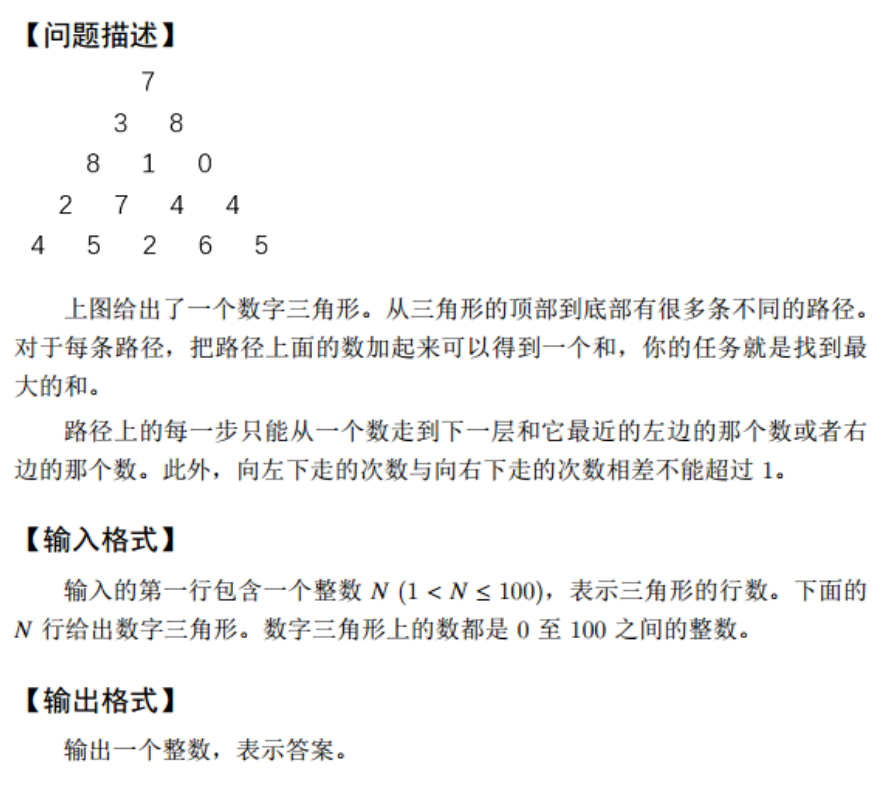
-
sample input
5 7 3 8 8 1 0 2 7 4 4 4 5 2 6 5
-
sample output
27
Brief description of ideas:
Go down from the top to the maximum sum of the current point = max (the sum of the values of the upper left point and the sum of the values of the upper right point) + the value of the current point
The difference between the number of times to go down left and the number of times to go down right cannot exceed 1
- Odd rows can only go to the middle of the last row
- Even rows can only go to the middle two numbers of the last row
code:
public static void main(String[] args) {
Scanner scanner=new Scanner(System.in);
int n=scanner.nextInt();
int [][]a=new int[n][n];
int [][]sum=new int[n][n];
for(int i=0;i<n;++i){
for(int j=0;j<=i;++j){
a[i][j]=scanner.nextInt();
if(i==0)sum[i][j]=a[i][j];
if(j<i)sum[i][j]=Math.max(sum[i-1][j]+a[i][j], sum[i][j]);
if(j>0)sum[i][j]=Math.max(sum[i-1][j-1]+a[i][j], sum[i][j]);
}
}
int ans=sum[n-1][n/2];
if(n%2==0){
ans=Math.max(sum[n-1][n/2-1],ans);
}
System.out.println(ans);
}
Question I: sum of substring scores (25 points)
Answer link:
Problem Description:
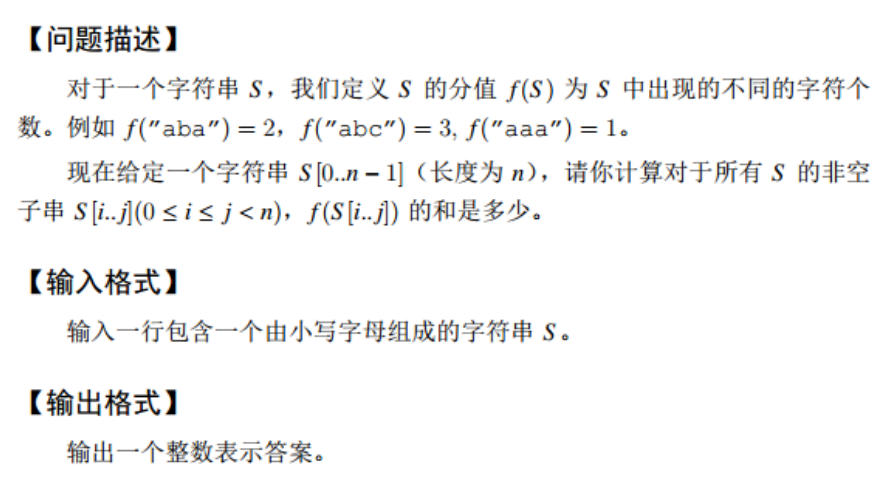
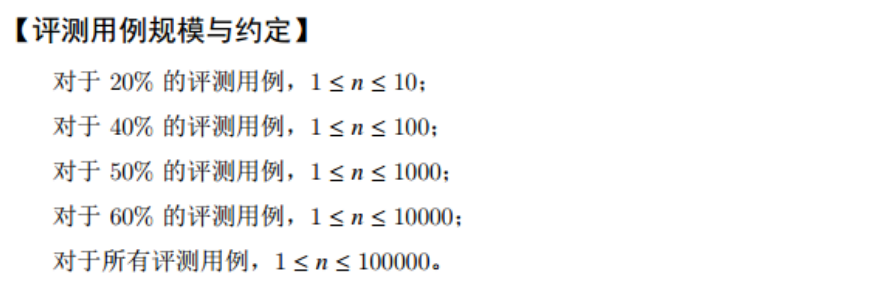
-
sample input
ababc
-
sample output
28
-
Example description
Substring f value a 1 ab 2 aba 2 abab 2 ababc 3 b 1 ba 2 bab 2 babc 3 a 1 ab 2 abc 3 b 1 bc 2 c 1
Brief description of ideas:
Use array a to store the last occurrence of 26 letters
Assuming that each interval is the first letter to appear and has a contribution value, the contribution value is the distance from the same letter on the left * the number of letters on the right
Pay attention to long
code:
public static void main(String[] args) {
Scanner scanner=new Scanner(System.in);
int a[]=new int[26];
Arrays.fill(a, -1);
String s=scanner.next();
int n=s.length();
long ans=0;
for(int i=0;i<n;++i){
int b=s.charAt(i)-'a';
ans+=(long)(n-i)*(i-a[b]);
a[b]=i;
}
System.out.println(ans);
}
Question J: decorative beads (25 points)
Answer link:
Problem Description:
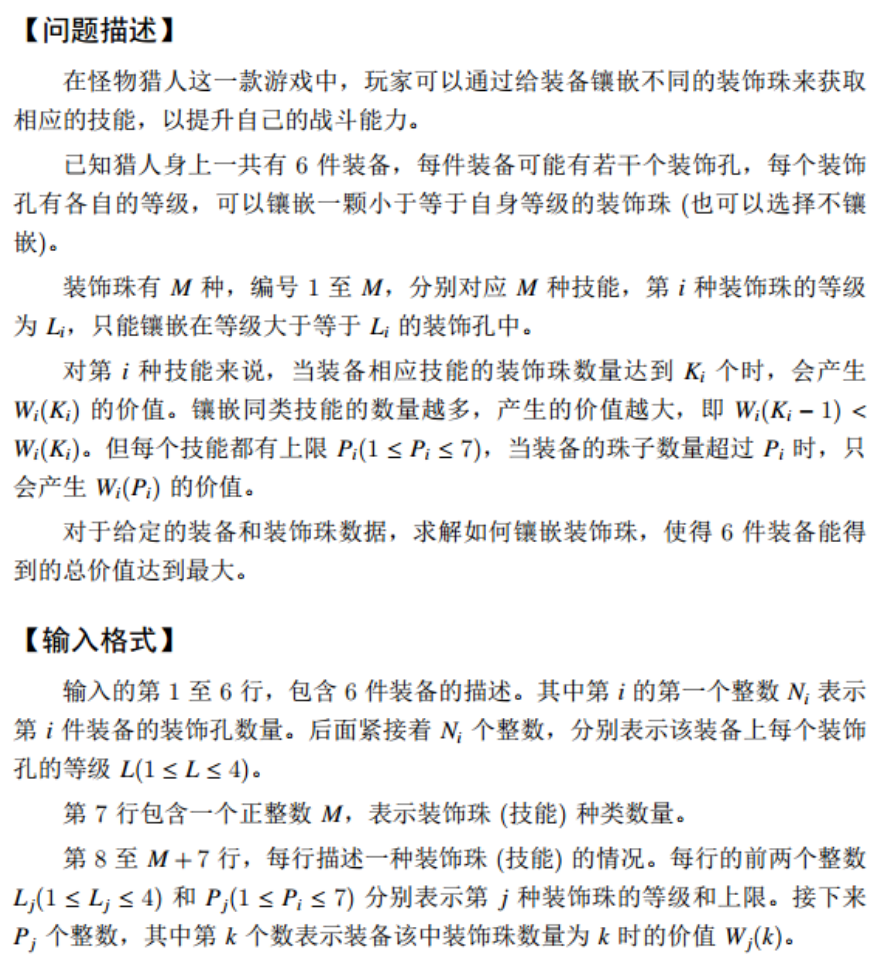

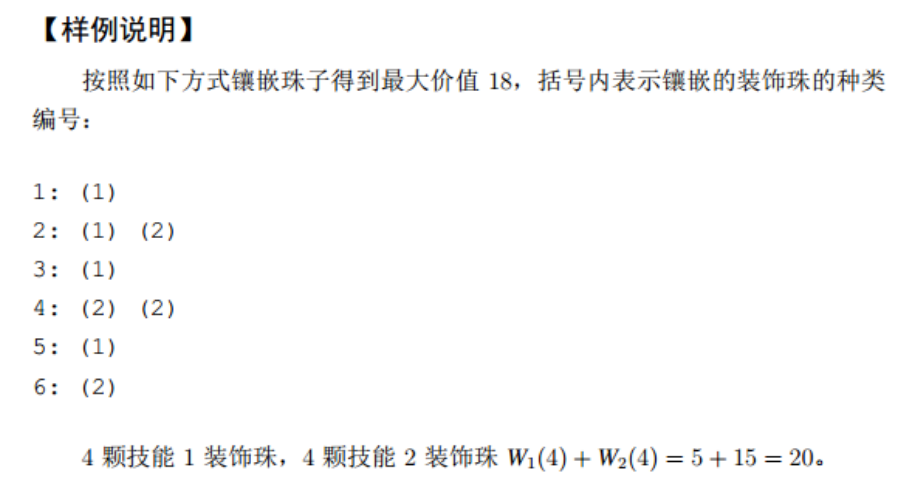

-
sample input
1 1 2 1 2 1 1 2 2 2 1 1 1 3 3 1 5 1 2 3 5 8 2 4 2 4 8 15 3 2 5 10
-
sample output
20
Brief description of ideas:
No
Welcome everyone to comment in the comment area